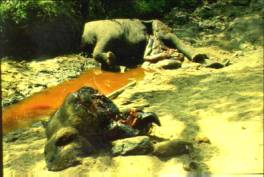The Asian Elephant: Conservation of a flagship species |
|
|
|
|
Prof. R. Sukumar
Centre for Ecological Sciences,
Indian Institute of Science,
Bangalore 560012, |
|
|
| Back |
STATUS AND DISTRIBUTION
|
|
 The Asian Elephant (Elephas maximus, Family: Elephantidae, Order: Proboscidea) is a threatened species that features in the 1996 IUCN Red List of Mammals, Appendix I of the Convention on International Trade in Endangered Species of Wild Flora and Fauna (CITES), as well as several national legislations such as Schedule 1 of the Indian Wildlife Protection Act (1972). Three subspecies have been recognized by zoologists, namely, Elephas maximus maximus (Sri Lankan elephant), Elephas maximus indicus (Asian Mainland elephant) and Elephas maximus sumatranus (Sumatran elephant). New genetic evidence, however, finds no basis for separating the Sri Lankan from the Mainland elephant. The former range of this species extended from Tigris-Euphrates basin eastward through Indian sub-continent and Southeast Asia to north of the Yangtze river in China. An estimated 45,000 wild Asian elephants are distributed in thirteen Asian countries, viz., India, Nepal, Bhutan, Bangladesh, Sri Lanka, Myanmar, Thailand, Laos, Cambodia, Vietnam, China (only southern Yunnan), Malaysia (peninsular Malaysia and Sabah) and Indonesia (Sumatra and Kalimantan).
The Asian Elephant (Elephas maximus, Family: Elephantidae, Order: Proboscidea) is a threatened species that features in the 1996 IUCN Red List of Mammals, Appendix I of the Convention on International Trade in Endangered Species of Wild Flora and Fauna (CITES), as well as several national legislations such as Schedule 1 of the Indian Wildlife Protection Act (1972). Three subspecies have been recognized by zoologists, namely, Elephas maximus maximus (Sri Lankan elephant), Elephas maximus indicus (Asian Mainland elephant) and Elephas maximus sumatranus (Sumatran elephant). New genetic evidence, however, finds no basis for separating the Sri Lankan from the Mainland elephant. The former range of this species extended from Tigris-Euphrates basin eastward through Indian sub-continent and Southeast Asia to north of the Yangtze river in China. An estimated 45,000 wild Asian elephants are distributed in thirteen Asian countries, viz., India, Nepal, Bhutan, Bangladesh, Sri Lanka, Myanmar, Thailand, Laos, Cambodia, Vietnam, China (only southern Yunnan), Malaysia (peninsular Malaysia and Sabah) and Indonesia (Sumatra and Kalimantan).
Elephant populations in most of the range states are spread across international borders. India holds about 60% of the total Asian elephants with over 25,000 in the wild. Of these, the largest populations, totaling between 10,500-14,500, are found in southern India, with sizeable numbers also seen in the northeast of the country. Myanmar comes next with an estimated population of 4000-5000 wild elephants, followed by Sri Lanka with over 3000 elephants. Sumatra (Indonesia) too has sizeable numbers, estimated at over 3000, but these are widely scattered in fragmented habitats and are also being captured in large numbers. The estimated population of about 1000 elephants in Peninsular Malaysia is stable, but the situation is not the same in Thailand, where populations are believed to be on decline. The island of Borneo is believed to have around 1000 elephants in the states of Sabah (Malaysia) and Kalimantan (Indonesia), but much of the range, especially in Sabah is being designated for other forms of land-use. Lao PDR and Cambodia are believed to have under 1000 and 500 elephants, respectively, while neighbouring Vietnam may hold less than 100 individuals. Similarly, the minor range states have few elephants, about 250 in the Yunnan province of China, similar numbers in Bangladesh and Bhutan, and less than 100 elephants in Nepal. In addition, 16,000 elephants are found in captivity, mostly in Myanmar, Thailand and India.
The 50000 sq. km range of this magnificent species spread across biologically diverse forests is home to four of the twenty-five global hotspots of biodiversity: Western Ghats; Eastern Himalayas (NE India, N. Burma, Southwest China); Peninsular Malaysia, Sumatra; Sabah and Kalimantan (Borneo). New species of mammals are still being found in this region having a significant proportion of the Asian biodiversity.
A comparison of the distribution of Asian elephants approximately 5000 years ago with the present distribution shows that they have retreated from the river valleys and plains, mainly because of the increase in human population and spread of civilizations in these regions. During the past century, even forest interiors have not been spared by an ever-increasing human population. Two significant issues that affect elephants today are (1) land development that destroys and fragments habitat, and (2) elephant-human conflicts (crop depredation and human mortality) resulting in local antagonism toward the elephant and its conservation.
THREATS
Habitat fragmentation
The elephants' habitat is exploited for fruits, fodder, fuel, etc. Developmental activities like hydroelectric projects, roads, railway lines and mining, and unsustainable agricultural practices and extensive logging have also robbed the elephant of its home. Natural forests have been cleared for planting oil palm, rubber, banana, millet, coconut, sugar cane, cocoa and paddy. Loss of habitat is not the issue in many elephant areas, but habitat fragmentation is.
Poaching
 Elephants are mainly hunted for their ivory, although their meat is also consumed in many parts of the world. Approximately 100 elephants are poached in India alone every year. Selective poaching of adult tuskers has skewed the sex ratio very significantly in many parts of the elephant habitat. The inappropriate demand of ivory for making hankos in Japan and handicrafts in the international market has created tremendous opportunities for smuggled ivory, and in many instances Asian elephant ivory has been passed off as African ivory. The demand for ivory is so significant that even elephant bones have been shaped and passed off as tusks.
Elephants are mainly hunted for their ivory, although their meat is also consumed in many parts of the world. Approximately 100 elephants are poached in India alone every year. Selective poaching of adult tuskers has skewed the sex ratio very significantly in many parts of the elephant habitat. The inappropriate demand of ivory for making hankos in Japan and handicrafts in the international market has created tremendous opportunities for smuggled ivory, and in many instances Asian elephant ivory has been passed off as African ivory. The demand for ivory is so significant that even elephant bones have been shaped and passed off as tusks.
Capture
The tradition of keeping elephants in captivity dates back to many centuries. It is estimated that between 30000 to 50000 elephants might have been captured throughout the Indian sub-continent during the past 100 years. They have been used for warfare, religious ceremonies, logging operations, etc. They are kept in temples, zoos, circuses, forest camps and resorts. The escalating human-elephant conflict requires problem animals to be captured and trans-located to other areas. In some instances, small populations have been captured for relocation to viable habitats. Some poaching groups are also engaged in capturing elephant calves for sale to temples and holiday resorts.
Human–Elephant Conflict
Elephant-human conflict refers to negative interactions between wild elephants and human, such as crop raiding by elephants, human injuries/deaths caused by elephants and killing of elephants for reasons other than ivory extraction. Crop raiding is a major problem in cultivation's abutting elephant habitats. The conflict is particularly acute in countries such as India and Sri Lanka that have large and high-density elephant and human populations. Farmers resort to traditional methods of driving elephants from their fields, like creating noise through firecrackers and carrying flame torches. They erect illegal electric fences by tapping electricity from the main transmission lines, which kill crop-raiding elephants. In the ongoing battle for space, many human beings also get killed. In India alone over 200 people are killed each year by wild elephants, with a large proportion of the incidents occurring in cultivated fields and settlements.
CONSERVATION
Anti-poaching efforts
Anti-poaching efforts should be taken up at the divisional level and the existing legislation should be strengthened, giving ample powers to the wildlife managers in curbing the crime. The anti-poaching units need to be strengthened with necessary monetary help, training and sufficient arms, ammunition, communication equipment and vehicles. Well-trained and motivated guards and foresters should be involved in anti-poaching activity. Poachers often use the knowledge and skills of the local people to track and kill elephants, hence. The locals should be educated on the evils of poaching and involved in anti-poaching efforts. All international trade in Asian elephant products is banned.
Alleviation of human-elephant conflict and securing of elephant corridors
 The most common types of elephant control are noise, elephant-proof trenches (EPT), electrified fences (e-fence), and capture or culling of rogue elephants. EPT's are the most widely used technique. E-fences probably function more as a psychological than a physical barrier as elephants learn that the wires produce regular short-duration high-voltage shocks on contact, and these fences perform effectively as long as they are maintained properly. Community electric fencing can be undertaken to keep elephants away from agricultural lands with the local community taking up the task of maintaining the fence and improve its efficiency. In some areas, elephant scaring squads equipped with firearms, fire crackers, vehicles and kumkies (tamed elephants used to chase or capture wild elephants) are used to chase elephants away from the crop fields and plantations. Rubble walls are also used to prevent elephant entry to certain areas. More recently, chemical repellent sprays have been tested with some success on raiding elephants in Africa. The same has to be tested on Asian elephants. The idea of a mechanical steel fence using old railway tracks is also being given due consideration.
The most common types of elephant control are noise, elephant-proof trenches (EPT), electrified fences (e-fence), and capture or culling of rogue elephants. EPT's are the most widely used technique. E-fences probably function more as a psychological than a physical barrier as elephants learn that the wires produce regular short-duration high-voltage shocks on contact, and these fences perform effectively as long as they are maintained properly. Community electric fencing can be undertaken to keep elephants away from agricultural lands with the local community taking up the task of maintaining the fence and improve its efficiency. In some areas, elephant scaring squads equipped with firearms, fire crackers, vehicles and kumkies (tamed elephants used to chase or capture wild elephants) are used to chase elephants away from the crop fields and plantations. Rubble walls are also used to prevent elephant entry to certain areas. More recently, chemical repellent sprays have been tested with some success on raiding elephants in Africa. The same has to be tested on Asian elephants. The idea of a mechanical steel fence using old railway tracks is also being given due consideration.
Land use policies in elephant habitats must be made clear to prevent further fragmentation of habitat or escalation of elephant-human conflict. The policies should be pragmatic enough to allow smaller fragmented forest patches to be taken up for development in order to maintain larger habitats intact. All developments in elephant habitats should be undertaken without affecting the corridors / traditional migratory routes of elephants. Wherever needed land should be purchased or notified to augment existing corridors. Local residents should be involved in corridor conservation by providing them incentives for maintaining their lands as corridors. Elephant population management – including the capture and translocation of herds from fragmented patches, the capture of notorious raiding bulls, or the occasional destruction of an animal that is a threat to human life – is essential in order to minimize conflict.
Text and photographs - Asian Nature Conservation Foundation



